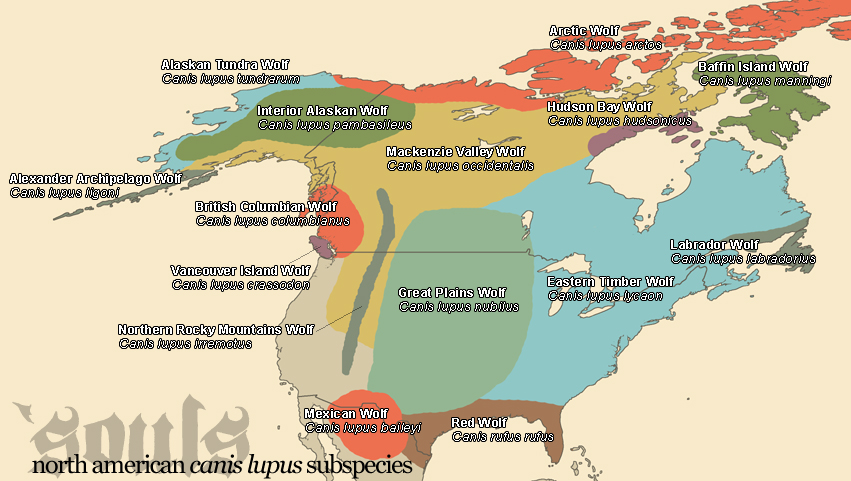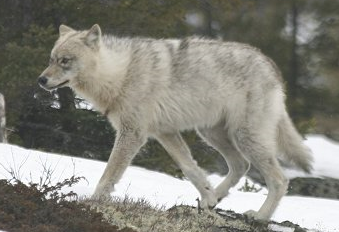Labrador Wolf (''Canis lupus labradorius'')
See our RP Guide for more extensive information regarding wolves.
On this page... (hide)
- 1. Common Names
- 2. 'Souls Range
- 3. Appearance
- 4. Other Characteristics
- 4.1 Social Life & Diet
- 4.2 Survival
- 4.3 Civilization
- 5. Citations
1. Common Names
Labrador Wolf
2. 'Souls Range
Labrador and Northern Quebec.
3. Appearance
Canis lupus labradorius, from cosmosmith.com
The coat of the Labrador Wolf shows the usual Gray Wolf variation of white to almost black and everything in between. The typical coat pattern is light gray, with a typically lighter underbelly and darker back. It is similar in general only larger than the Eastern Timber Wolf; yet it is likely there would be far less evidence of potential coyote interbreeding with the Labrador Wolf than the Eastern Timber Wolf.
The Labrador Wolf is a larger-sized subspecies, although it possesses a more lean bodily structure than the comparably-weighing Hudson Bay Wolf. It can range in length from about 4.5 to 6 feet (1.5 - 1.8 meters), and can weigh from 75 to 140 pounds (34 - 63.5 kg).
4. Other Characteristics
Some question whether the Labrador wolf is a distinct subspecies or not. Some people call it the grey wolf or timber wolf, while others claim it's a separate species found only in Labrador and northern Québec. Because of its elusiveness and the vast, rugged land it occupies, it is one of the least studied wolves in the world. Labrador wolves are also rarely photographed in the wild.
4.1 Social Life & Diet
Labrador wolves hunt one of the largest herds of caribou in the world. They also prey on moose, musk ox, hares, beaver, and other rodents and fish. Their semi-nomadic lifestyle leaves them with medium-sized packs of about twenty-five canines. To follow with the migrations of the herd and sustain themselves, these canines generally occupy vast territories.
4.2 Survival
Prior to the extinction of humanity in 1988, this canine's original range was mostly untouched; despite their stable populations, due to this canine's numbers, it was regarded as endangered. However, since the destruction of humanity, they have flourished further, certainly within the range of a healthy population.
4.3 Civilization
Feral lifestyles are preferred by these canines. They shift to ease hunting and interaction with the world, but it is rare to find them living in cities or even using old human homes as dens.
5. Citations


